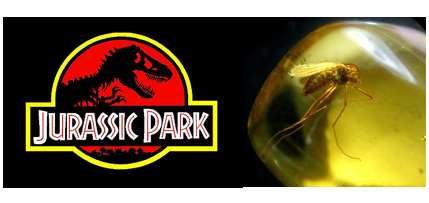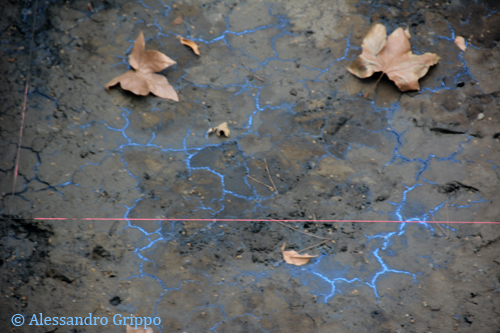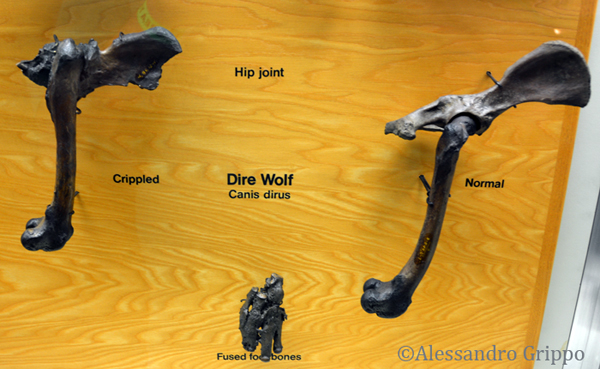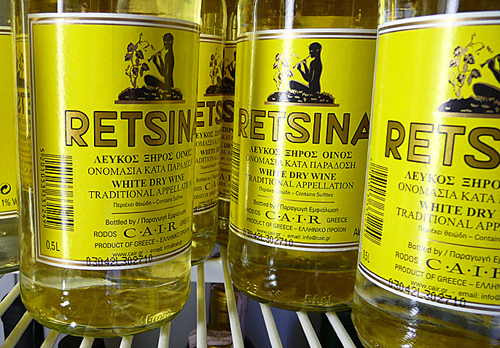
| |||||||||||||||
| Introduction | Last Updated • May 19, 2019 | ||||||||||||||
The last two Lagerstätten we are going to look into are peculiar for their unusual method of preservation. When we studied the ways in which fossils can be preserved (see notes on paleontology) we observed that the common fossilization processes tend to give us incomplete, or in any case not good fossils. A few others instead were less common but the preservation that results is excellent. On the island of Hispaniola, preservation in amber allows us to observe and study a whole forest of insects and more, that would have otherwise be lost. At the La Brea tar pits, asphalt has preserved thousands and thousand of bones of a myriad organisms. And preservation in ice from Siberia and Alaska, described at the end of the Rancho La Brea chapter, adds to the discussion.
The Dominican Amber Lagerstätten is late Early to earliest Middle Miocene from the Dominican Republic, on the Caribbean island of Hispaniola. The Rancho La Brea fossils are from the Pleistocene and so are the fossil from the Siberian and Alaskan permafrost.
Here is a map of the World in the Miocene, about 14 million years ago, the time of the Dominican Amber.
Notice that, even in the Miocene representation, the geographical configuration was not that different from that of today. | Dominican Amber
| Last Updated • May 19, 2019 | The first concept that the authors outline in this chapter is that preservation in amber provides a fossil record that is limited to a very small geographical area. Amber can not really be transported, so only organisms that happen to be close to it can become trapped in tree resin. This perspective is very different from what we saw earlier, for instance in Florissant, where wind and water brought animals and plants from other areas onto the lake surface. In that case, fossils belonged to a variety of different environments and not only to the lake. This paragraph also outlines other differences that exist between preservation in amber and other, more common kinds of preservation, from the type of fossil, to the quality of preservation, to the bias in the record. Be aware of all these factors. Finally, the processes of change from tree resin to copal and to amber are outlined. Know the differences between those, and the characteristics of each. Amber has been identified in very ancient jewelry pieces and the Romans and the Greeks knew it well. The Roman Pliny the Elder (see below) wrote about it in the year 77, pointing out for the first time in history that it came from the induration and fossilization of tree resins. Pliny knew about the amber from the Baltic Sea, along the coasts of Denmark, Germany, Sweden, and Poland, so the Baltic amber is the first ever to have been described and studied. .. liquidum id (glaesum) primo destillare argumento sunt quaedam intus tralucentia, ut formicae culicesque et lacertae, quae adhaesisse musteo non est dubium et inclusa durescente eodem remansisse .. it (amber) is first exuded as a liquid, and another reason for that is that there are certain things that show through it, such as ants, gnats, and lizards, that undoubtedly were stuck to the fresh sap and remained in it during the hardening process (from Natural History, Pliny the Elder, free translation)  A 1669 edition of Pliny the Elder's Natural History, originally written in the year 77
Amber from the Dominican Republic was first identified and described by another Italian, Christopher Columbus, in 1492, upon his landing on Hispaniola. For centuries though it was not traded commercially and it is only now becoming more common on the market than the Baltic one. Hispaniola is a Caribbean island situated between Cuba and Puerto Rico. It hosts two countries on its ground, French-speaking Haiti and the Spanish-speaking Dominican republic. Dominican amber is found within two distinct formations in the Northern Cordillera (La Toca Formation) and the Eastern Cordillera (Yanigua Formation) on the Dominican side of the island of Hispaniola. Both formations are Early to Middle Miocene in age (19 to 16 million years ago). The two different areas of amber presence actually indicate different sedimentary facies, even if they seem to belong to the same sedimentary basin. The La Toca Formation consists of sandstones containing thin beds of lignite and some conglomerates. The Yanigua formation instead is mostly lignite and sandy clay. The amount of detail preserved in amber-encased fossils is exceptional: insects and arachnids for instance have been known for showing both internal organs and structure and, on electron microscope analysis, internal cell materials. Organisms preserved in amber are subject to mummification. Mummification implies dehydration (loss of water), a process that can cause shrinkage up to 30% of the original body volume; amber would still allow oxygen diffusion (and hence potential decay) but its fixative and antibacterial properties would allow preservation of organic matter. The penetration of oxygen though implies that that amber cannot be used in the study of ancient atmospheres as it was originally hoped). For these reasons, known in antiquity, resin was used by the Egyptians for mummy preservation. The traditional Greek wine retsina is made with resin addition to prevent oxidation to vinegar. 
The resin-packed interior of a Theban mummy's skull.
Bottles of retsina, with its characteristic yellow color. Attempts have been at DNA extraction from amber, but so far none has been successful. It was already know that DNA breaks down very quickly after cell death, but the better comprehension of the process of diffusion of oxygen in amber that we have now makes scientists think that it is going to be highly unlikely that DNA molecules could survive geologic time.
 Plants and insects are the most common (and important) find in Dominican amber. What follows is a simple summary of this section. You should not concentrate as much on the names of these creatures, but rather on their environmental significance. Many of them are still found today in a tropical forest. What does that tell us? Plants
Nematodes and Mollusks
The most common inclusions in amber come from flying insects
These are bigger organisms and rarely get preserved in their entirety, or directly. Their presence can be inferred from hair, feathers, or the presence of parasites specific to certain organisms.
We already said that amber can only sample the environment, leaving behind big creatures or creatures that cannot be involved with tree resin for other reasons. Be able to describe the ancient environment based on the evidence, and the interpretations that can be offered. But also be able to discuss why the data we have are interesting in other ways, including a possible effect of climate change on these faunas and floras. Be able to talk about why you would have more ants in Dominican amber when compared to Baltic amber. What trees produced Baltic amber? Why is Dominican amber regarded as superior to all other ambers? | Rancho La Brea (and the Permafrost of Siberia and Alaska)
| Last Updated • May 19, 2019 | The Quaternary Period begins about 2.5 million years ago. Since the break-off of Antarctica from South America, Earth was in an icehouse state, but at the beginning of the Quaternary, even colder conditions were established on northern continents. During these last 2.5 million years we had alternation of colder spells and relatively warmer interglacial intervals (like that we are living in today). These oscillations between colder and warmer intervals, always within a "Great Ice Age", which is always part of Earth's icehouse state, were modulated by the three parameters of Milankovitch frequencies we have studied in class. These variations in climate allow us for a finer subdivision of geologic time than that allowed by fossil zones, particularly when we take into account the cycles of eccentricity of the Earth's orbit and of the precession of the equinoxes. Around 10,000 years ago, mammals across the globe underwent severe changes, with a high percentage of extinctions. We are still not certain about the cause for this extinction event, some speculate it was the intensification of human hunting (but did we have enough humans to cause this? With different civilizations scattered throughout the globe and at different stages of evolution?), others maintain that the change originated in further climate variation. The La Brea Tar Pits (Rancho La Brea) in the city of Los Angeles offers one of the world's richest deposits of Ice Age fossils, preserved in asphalt-rich sediments, providing us with an exceptional, albeit partial view of this ecosystem. Read this section for completeness of information, but there will be no questions out of it. 

Asphalt seeping through the soil at the bottom of a pit at Rancho La Brea
You do not need to memorize all fossil knows at the tar pits but be aware of their existence and their ecological significance
Be able to describe the environment of the Los Angeles Basin and the Santa Monica Mountains during the time of deposition of the asphalt at the La Brea tar pits. For instance, why would there be a bias in preservation in favor of carnivores over herbivores? Why are there more young, wounded, and older animals than regular adults? 
Display case with the bones of wounded dire wolves compared to those of healthy individuals. We see a lot of animals and it is easy to think that they all died at the same time in order to be so abundant. Still, an entrapment episode occurring every 10 years would be enough to account for the number of mammals represented in the collections. The permafrost of Siberia and Alaska A different kind of preservation agent acted at the same time the La Brea animals were fossilized in asphalt: ice. Many animals found refuge from advancing continental glaciers by moving at their front in what we still think of extremely cold areas.
© Alessandro Grippo, since 1994 | |||||||||
